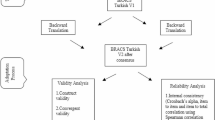Abstract
Botulinum toxin type A (BTA) injection in intrinsic laryngeal musculature may result in dysphagia and consequent loss of quality of life (QOL) in a percentage of patients. This study aims to evaluate pharyngeal motility as a putative cause for this change in swallow quality in light of high-resolution manometry (HRM). Twenty patients (95% females, median age 66 years) underwent high-resolution manometry before and after BTA injection. Dysphagia was evaluated based on a QOL dedicated questionnaire (SWAL-QOL) before and after BTA injection. Pharyngeal motility at the topography of the vellum, epiglottis, and upper esophageal sphincter (UES) were recorded. Eleven (55%) subjects had worsened QOL after BTA injection. In patients with worsened QOL, UES extension decreased (p = 0.005), UES residual pressure increased (p = 0.02), UES basal pressure decreased (p = 0.04), and velopharynx contraction duration decreased (p = 0.04). UES residual pressure increased (p = 0.01), velopharynx peak pressure (p = 0.04) and upstroke (p = 0.007) decreased in patients with maintained QOL. There was no difference between groups when comparing pre-injection values. UES extension (p = 0.01) and UES maximum relaxation time (p = 0.03) was lower in the group with worsened QOL after BTA as compared to no change in QOL. Pharyngeal motility as measured by HRM was not a predictor for post procedure dysphagia and the changes in motility after BTA injection does not seem to be a strong contributor to dysphagia.

Similar content being viewed by others
References
Blitzer A, Sulica L. Botulinum toxin: basic science and clinical uses in otolaryngology. Laryngoscope. 2001;111(2):218–26. https://doi.org/10.1097/00005537-200102000-00006.
Teive HAG, Scola RH, Werneck LC, Quadros A, Gasparetto EL, Sá DS, Brandi IV, Macedo Filho ED. O uso da toxina botulínica no tratamento da distonia laríngea (disfonia espasmódica): estudo preliminar com doze pacientes. Arq Neuropsiquiatr. 2001;59(1):97–100. https://doi.org/10.1590/S0004-282X2001000100020.
Bielamowicz S, Stager SV, Badillo A, Godlewski A. Unilateral versus bilateral injections of botulinum toxin in patients with adductor spasmodic dysphonia. J Voice. 2002;16(1):117–23. https://doi.org/10.1016/S0892-1997(02)00080-2.
Adler CH, Bansberg SF, Hentz JG, Ramia LO, Buder EH, Witt K, Edwards BW, Krein-Jones K, Caviness JN. Botulinum toxin type a for treating voice tremor. Arch Neurol. 2004;61(9):1416–20. https://doi.org/10.1001/archneur.61.9.1416.
Blitzer A. Spasmodic dysphonia and botulinum toxin: experience from the largest treatment series. Eur J Neurol. 2010;17:28–30. https://doi.org/10.1111/j.1468-1331.2010.03047.x.
Silva LC, Herbella FA, Neves LR, Vicentine FP, Neto SP, Patti MG. Anatomophysiology of the pharyngo-upper esophageal area in light of high-resolution manometry. J Gastrointest Surg. 2013;17(12):2033–8. https://doi.org/10.1007/s11605-013-2358-3.
Miler RH. Technique of percutaneous EMG-guided botulinum toxin injection of the larynx for spasmodic dystonia. J Voice. 1992;6(4):377–9. https://doi.org/10.1016/s0892-1997(05)80037-2.
Pontes P, De Biase NG, Gadelha ME. Clinical Evolution of Laryngeal Granulomas: treatment and prognosis. Laryncoscope. 1999;109(2):289–94. https://doi.org/10.1097/00005537-199902000-00021.
Larrosa F, Idı́gora A, Aguilar F, Riera L, Martı́ MJ, Valls J. Results of using botulism toxin in the treatment of spasmodic dysphonia. Acta Otorrinolaringol Esp. 2002;53(1):27–31. https://doi.org/10.1016/S0001-6519(02)78277-0.
Roy N. Differential diagnosis of muscle tension dysphonia and spasmodic dysphonia. Curr Opin Otolaryngol Head Neck Surg. 2010;18(3):165–70. https://doi.org/10.1097/moo.0b013e328339376c.
Guglielmino G, Moraes BT, Villanova LC, Padovani M, De Biase NG. Comparison of botulinum toxin and propranolol for essential and dystonic vocal tremors. Clinics. 2018;73:e87. https://doi.org/10.6061/clinics/2018/e87.
Chang CY, Chabot P, Thomas JP. Relationship of botulinum dosage to duration of side effects and normal voice in adductor spasmodic dysphonia. Otolaryngol Head Neck Surg. 2007;136(6):894–9. https://doi.org/10.1016/j.otohns.2007.01.035.
McHorney CA, Robbins J, Lomax K, Rosenbek JC, Chignell K, Kramer AE, Earl Bricker D. The SWAL-QOL and SWAL-CARE outcomes tool for oropharyngeal dysphagia in adults: III. Documentation of reliability and validity. Dysphagia. 2002;17(2):97–114. https://doi.org/10.1007/s00455-001-0109-1.
Portas JG (2009) Validação para a línguaportuguesa-brasileira dos questionários: qualidade de vida em disfagia (Swal-qol) e satisfação do paciente e qualidade do cuidado no tratamento da disfagia (Swal-care). Dissertation, Fundação Antônio Prudente.
Blitzer A, Brin MF, Stewart C. Botulinum toxin management of spasmodic dysphonia (laryngeal dystonia): a 12 year experience in more than 900 patients. Laryngoscope. 1998;108(10):1435–41. https://doi.org/10.1097/00005537-199810000-00003.
Altman KW, Atkinson C, Lazarus C. Current and emerging concepts in muscle tension dysphonia: a 30-month review. J Voice. 2005;19(2):261–7. https://doi.org/10.1016/j.jvoice.2004.03.007.
De Moraes BT, De Biase NG. Laryngoscopy evaluation protocol for the differentiation of essential and dystonic voice tremor. Braz J Otorhinolaryngol. 2016;82(1):88–96. https://doi.org/10.1016/j.bjorl.2015.11.001.
Rogozhin AA, Pang KK, Bukharaeva E, Young C, Slater CR. Recovery of mouse neuromuscular junctions from single and repeated injections of botulinum neurotoxin A. J Physiol. 2008;586(13):3163–82. https://doi.org/10.1113/jphysiol.2008.153569.
Sallum RA, Duarte AF, Cecconello I. Analytic review of dysphagia scales. Arq Bras Cir Dig. 2012;25(4):279–82. https://doi.org/10.1590/s0102-67202012000400013.
Meier-Ewert HK, Herwaarden MA, Gideonc RM, Castell JA, Achem S, Castell DO. Effect of age on differences in upper esophageal sphincter and pharynx pressures between patients with dysphagia and control subjects. Am J Gastroenterol. 2001;96(1):35–40. https://doi.org/10.1111/j.1572-0241.2001.03448.x.
Williams RBH, Wallace KL, Ali GN, Cook IJ. Biomechanics of failed deglutitive upper esophageal sphincter relaxation in neurogenic dysphagia. Am J Physiol Gastrointest Liver Physiol. 2002;283(1):G16–G26. https://doi.org/10.1152/ajpgi.00189.2001.
Xue S, Katz PO, Castell JA, Castell DO. Upper esophageal sphincter (UES) and pharyngeal (P) manometry: which patients?? Gastroenterology. 2000;118(4):A410. https://doi.org/10.1016/s0016-5085(00)83749-x.
Bhatia SJ, Shah C. How to perform and interpret upper esophageal sphincter manometry. J Neurogastroenterol Motil. 2013;19(1):99–103. https://doi.org/10.5056/jnm.2013.19.1.99.
Wilson JA, Pryde A, White A, Maher L, Maran AG. Swallowing performance in patients with vocal fold motion impairment. Dysphagia. 1995;10(13):149–54. https://doi.org/10.1007/BF00260968.
Shaker R, Dodds WJ, Dantas RO, Hogan WJ, Arndorfer RC. Coordination of deglutitive glottic closure with oropharyngeal swallowing. Gastroenterology. 1990;98(6):1478–84. https://doi.org/10.1016/0016-5085(90)91078-k.
Eibling DE, Gross RD. Subglottic air pressure: a key component of swallowing efficiency. Ann Otol Rhinol Laryngol. 1996;105(4):253–8. https://doi.org/10.1177/000348949610500401.
Funding
Funding was provided by Coordenação de Aperfeiçoamento de Pessoal de Nível Superior.
Author information
Authors and Affiliations
Corresponding author
Additional information
Publisher's Note
Springer Nature remains neutral with regard to jurisdictional claims in published maps and institutional affiliations.
Rights and permissions
About this article
Cite this article
Mororó, W.C., Herbella, F.A., de Oliveira, K.V.G. et al. Pharyngeal Motility Before and After Thyroarytenoid Muscle Botulinum Toxin Injection. Dysphagia 35, 806–813 (2020). https://doi.org/10.1007/s00455-019-10086-x
Received:
Accepted:
Published:
Issue Date:
DOI: https://doi.org/10.1007/s00455-019-10086-x




